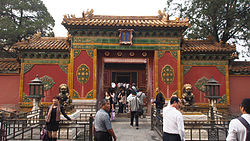| Hall of Mental Cultivation | |
|---|---|
| Native names | |
 Outside the Hall | |
| Location | The Forbidden City |
| Nearest city | Beijing |
| Coordinates | 39°55′06″N 116°23′22″E / 39.91835°N 116.38940°E |
| Built | 1537 |
| Original use | Residence of the emperor, governance, administration |
| Rebuilt | During the Qing dynasty |
| Restored by | The Palace Museum, Beijing |
| Current use | Tourist destination |
| Governing body | The Palace Museum, Beijing |
The Hall of Mental Cultivation (simplified Chinese: 养心殿; traditional Chinese: 養心殿; pinyin: Yǎngxīn Diàn, Manchu: ᠶᠠᠩ
ᠰᡳᠨ
ᡩᡳᠶᠠᠨ yang sin diyan) is a building in the inner courtyard of the Forbidden City in Beijing, China. The hall is a wooden structure with dome coffered ceilings, and was first built during the Ming dynasty in 1537, and was reconstructed during the Qing dynasty.[1] During the early Qing dynasty under the reign of the Kangxi Emperor the hall was mostly used as a workshop, wherein artisan objects like clocks were designed and manufactured.[1][2][3] From the reign of the Yongzheng Emperor during the 18th century, the hall was the residence for the emperor.[1] Under the reign of the Qianlong Emperor until the fall of the Qing dynasty, the hall became the centre of governance and political administration.[1] In the Western Warmth Chamber, the emperor would hold private meetings, and discuss state affairs with his mandarins.[1] After the death of Emperor Xianfeng, from inside the Eastern Warmth Chamber, empress dowagers Ci'an and Cixi would hold audiences with ministers and rule from behind a silk screen curtain during their regencies for emperors Tongzhi and Guangxu, who both succeeded to the throne as children in the second half of the 19th century.[1][4]
The Hall of Mental Cultivation contained the Hall of Three Rarities, which stored art and cultural relics, and the Qianlong Emperor's collection of 134 model calligraphy works from the Imperial Collection.[1][5] He also housed three ancient calligraphy artworks by ancient calligraphers Wang Xizhi, Wang Xianzhi and Wang Xun.[6][7]
The hall's interior is decorated with polychrome paintings, glazed tiles, ancient thangkas, and traditional wax paper decorations. From 2006, the Palace Museum instigated a research and conservation project aimed at restoring the hall, and preserving its cultural relics like thangkas.[8]
In anticipation of the hall's closure due to restoration in 2018, in 2017 the Palace Museum launched a digital exhibition about the Hall of Mental Cultivation.[9]
- ^ a b c d e f g Cite error: The named reference
:0was invoked but never defined (see the help page). - ^ Cite error: The named reference
:6was invoked but never defined (see the help page). - ^ Cite error: The named reference
:7was invoked but never defined (see the help page). - ^ Cite error: The named reference
:14was invoked but never defined (see the help page). - ^ Cite error: The named reference
:15was invoked but never defined (see the help page). - ^ Cite error: The named reference
:16was invoked but never defined (see the help page). - ^ Cite error: The named reference
:8was invoked but never defined (see the help page). - ^ Cite error: The named reference
:2was invoked but never defined (see the help page). - ^ Cite error: The named reference
:4was invoked but never defined (see the help page).
